(Denton Welch, The Coffin House, watercolor and ink on paper, 1946, private collection. Recently on show at Tibor de Nagy’s “Town and Country”.)
Yearly Archives: 2010
georges perec, “an attempt at exhausting a place in paris”
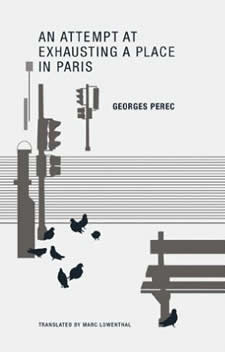 Georges Perec
Georges Perec
An Attempt at Exhausting a Place in Paris
(trans. Marc Lowenthal)
(Wakefield Press, 2010)
This is the third book from Wakefield Press: it presents a full translation of Georges Perec’s An Attempt at Exhausting a Place in Paris. This is a minor work in the Perec landscape, which receives only a glancing mention in David Bellos’s enormous biography. It’s encouraging that there have been a steady flow of new Perec books, no matter how small: 2008 saw Atlas publish Cantatrix Sopranica L.: Scientific Papers, and last year saw David Godine publish Thoughts of Sorts, both previously excerpted in Penguin Species of Spaces (as well as the revised translation of Life a Users Manual, of course). It’s nice seeing Perec’s books as small self-contained objects; the Penguin volume, which presents a lot of material, is too easy to skip through. At 55 pages, this book is shorter than the other two, short enough for me to read on the brief flight from Norfolk, Virginia to Baltimore, though it’s a book that demands re-reading.
As the length suggests, this is a self-consciously minor work: it might be considered an investigation in boredom. Perec chose a place in Paris – Place Saint-Sulpice (visible, not particularly well, on Google Earth and visited it nine times from the 18th to the 20th of October, 1974, four times the first day, less on the following ones, attempting to write down everything he saw. The results are this book. There is pointedly nothing particularly remarkable about the location, and in his introduction Perec makes clear his intention not to write about Saint-Sulpice’s notable features: rather, Perec was attempting to find something interesting in the ordinary, a project that he’d soon expand (restricting the span of time, but increasing the space to an entire building) into Life a User’s Manual.
This is a personal exercise, and because it follows his attempts over time, it feels very much like a series of notes: the reader observes the observer, and how he begins to notice things. He starts his first session by writing down all the text that he can see, then moving on to different sorts of categories (“fleeting slogans,” “ground,” “trajectories,” “colors”). Things start quickly: he’s trying to get everything down. Then there’s a slowing: he tries to notice what changes over time. For a while he’s preoccupied with the many buses that pass through the square (the second section is largely a record of the buses that pass as he watches); then he gets bored of noting the buses; and finally in in the fourth section he realizes that he can describe a bus not simply by the number of its route or where it’s going but by how full it is. It’s a tiny moment of revelation: of looking at something ordinary long enough to see something new in it.
A few personal details pop up: he tells what he’s eating or drinking, and a couple of times he sees people pass that he recognizes. One wonders how personal some of the details might be: why, for example, does he mention an”apple-green 2CV” over and over? Is it the same car? Was there a reason that his attention might be drawn to this make and color of car over others? Or were there simply a lot of them in Place Saint-Sulpice in 1974? The writer is sometimes bored with his project; one wonders why he stopped on the third day. By writing on a Friday, a Saturday, and a Sunday, he’s presumably covered most of the weekly variation likely to occur; but looking longer might have brought more out. Perhaps it’s left as an exercise for the reader.
Perec’s project is a generative one, of course. Reading it, I found myself thinking most often of Daniel Spoerri’s work, first his “snare paintings,” where he’d glue down the detritus of a meal to the table and exhibit it on the wall; later, he created a literary equivalent of this in his Anecdoted Topography of Chance, mentioned in Marc Lowenthal’s very nice translator’s note. In both, Spoerri was attempting to create meaning from trash; the Topography uses trash on a table to generate narrative, albeit a narrative more personal than Perec’s. Spoerri and his friends could generate a narrative from their personal trash because there was something personal that could be seized upon there: how the trash got on the table, where the trash was from. Lowenthal also mentions Joe Brainard’s I Remember, another generative trick that Perec brought into French; this also relies on the personal. What Perec is doing in An Attempt might be something trickier: he’s trying to make an utterly anonymous public space personal. It’s a difficult job: ultimately, this is more of a record of Perec’s time there over three days rather than a depiction of a place. Perec isn’t depicting the square, he’s exhausting it (as well as himself); by the end, he clearly wants to go home. This is a lonely book.
I’m still kicking myself for missing MoMA’s program of Perec’s film work a few years back; I suspect that familiarity with his work in film, generally inaccessible in this country, might illuminate this book a bit more. One can’t have everything, I guess; it’s nice that we have as much of Perec’s writing in English (and in print) as we do now. Again, it makes me happy that Wakefield is publishing books like this: most publishers wouldn’t bother with a slip of a book like this, no matter how well it works. This book is as attractive as the two previous books from Wakefield, the first of their “Imagining Science” series; I’m curious to see where they’ll go with that. The paper is thick: it’s a pleasure to read. As mentioned, the translator’s note at the end of the book by Marc Lowenthal helpfully explains the text without lapsing into the overly academic; this kind of attention to detail is important, and it makes Wakefield’s work worth following. I’m particularly interested to see how their volume of Fourier turns out: but that’s next year.
august 2–august 10
Books
- Ettie Stettheimer, Love Days [Susanna Moore’s]
- Alvin Levin, Love Is Like Park Avenue
- John Crowley, Lord Byron’s Novel: The Evening Land
- Joseph McElroy, Preparations for Search
Films
- Man on Wire, directed by James Marsh
- Grizzly Man, dir. Werner Herzog
- The Hours, dir. Stephen Daldry
joseph mcelroy, “preparations for search”
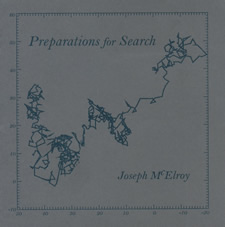 Joseph McElroy
Joseph McElroy
Preparations for Search
(Small Anchor Press, 2010)
This is a short book, a chapbook really, of material that was cut from Joseph McElroy’s biggest work, Women and Men. An earlier version of this was published in the journal Formations in 1984; I can’t tell why this is coming out now. A volume of McElroy’s stories is coming out in the fall from Dalkey Archive; I don’t know if that includes this, though I suspect it doesn’t. For the past few years, he’s been reading from a short novel called Cannonball which still doesn’t seem to have found a publisher, and he seems to still be working on his non-fiction book on water, which I’ve been awaiting impatiently. But any new McElroy material, no matter how unexpected, is a source of excitement to me: this is a small book, but one that lends itself to re-reading.
The plot is easily related: a character named Enos comes to the narrator, Bethel, asking to borrow $1100 so that he can hire a detective to find his father, who left when he was two. The narrator is reticent to do this; other characters (who seem to be in their late twenties and early thirties in downtown New York in the early 1980s) are consulted, and a world is quickly fleshed out around this initial situation; it’s similar to when a pebble dropped into still water, and ripples move across an entire pond, hit the edges, and are reflected to create complex and unpredictable patterns. Here the patterns are created in the people in Enos and Bet’s worlds: their girlfriends, their relations, their friends. A world is slightly destabilized; it struggles to come back to stability. The interest in the book is in seeing how the characters react to a change – a slight one, but still a change – in their environment: it could be said that this is an ecological approach to fiction.
There’s something distinctive about the voice McElroy uses: I’ve always suspected that Don DeLillo learned a few tricks from him, though DeLillio amplifies the voice until it becomes cartoonish. It’s an internal narration, but it’s an oral narration: you can hear the narrator saying what he relates, the rhythms are those of speech rather than that of the page. In this section Bet puzzles out a relationship; Matt is Enos’s father; Elizabeth wrote Enos’s mother a letter long ago:
Elizabeth had worked with Matt in the office of a lumberyard in Salem, and she loved him though she didn’t think he was the marrying kind, as she put it. But why were Susan and I piecing together this old story as if it were not so full of gaps as hardly to be a story? What did Elizabeth look like, I guess you always want to know. The letter had been typed and was the only news Enos’s mother had ever had. Confusing, for at the time Elizabeth wrote it, Matt had just the week before quit the lumberyard in Oregon and gone down to California, to San José, where he had a job working construction. There was more to it than that. Susan recalled that this woman Elizabeth had been already once a grace widow.
As for me, I remembered what Susan didn’t know – that the lumber firm in Salem sold out soon afterward. But Susan now recalled that Matt’s girlfriend Elizabeth had been planning to leave Salem anyway. I now recalled that the former manager of the lumberyard there was named Deed, and he had been the one who according to Elizabeth’s letter had told her that Matt was in trouble as a labor agitator down in California. (p. 24)
The words are very simple; but the syntax is complicated, looping back and forth to cover a range of times. As the concern for “this old story” suggests, it’s a carefully literary voice: what’s being recounted here is something that’s past what a single oral narration could explain, a complexity that only literary writing can deal with properly. The section breaks create a rhythm only possible on the page, and the system of quotation – no quotes for recounted dialogue, quotation marks for dialogue that is happening in real time – suggests that thought has gone into creating something that works as a text. An auditor is occasionally possible; it’s hard to tell if this auditor is another character or the reader trying to understand the text.
It’s a dry voice: there are echoes of the disinterested way in which Kafka relates “In the Penal Colony,” for example, though the use to which that voice is being put is very different: McElroy is deeply interested in the social world that seemed to terrify Kafka: rather than depicting a mechanistic world, the result of positivism, he depicts a world that’s deeply complex because of the myriad interactions.
Preparations for Search seems to almost be a miniature version of The Letter Left to Me (the short novel that McElroy wrote after Women and Men: to my mind it works a bit better than that book because of its extreme compression, but Letter explores this book’s concerns about the meaning of paternity more deeply. McElroy works by digression: digression for him is a tool to achieve verisimilitude in a complex world. I think his reputation has suffered slightly because of the shallowing of the pool of readers between the 1980s and the present: his work is unremittingly serious, an attempt to use fiction to think about the problems faced by the modern world, and I think that today’s readership, driven to distraction by endless amounts of entertainment, has a harder time sitting down with his large books. This is a shame: his work hasn’t lost anything over time but its audience; maybe his output of shorter works this year will regain some of that.
It’s hard to tell very much about Small Anchor Press, the publisher, from their website; they seem to be new and based in Brooklyn, and it’s unclear to me how they came to be publishing McElroy. Preparations for Search is an attractive volume: the front cover looks good, though I don’t entirely understand the rationale for the square form, as it’s difficult to make a text block look good on a square page; consequently, the measure is a bit too wide for my taste. The presentation is a bit oblique as well: the text is composed of different sections, some only a paragraph long, and section breaks have become page breaks, giving the book an almost aphoristic look. This becomes confusing with longer sections that span pages (a problem also found when setting poetry); it can be hard to know whether a paragraph break at the end of the page is a section break as well, which matters when the sections present discontinuous moments in the book’s narration. But these are quibbles: it’s nice to see any new McElroy work, and any press that’s publishing him is worth keeping an eye on.
john crowley, “lord byron’s novel: the evening land”
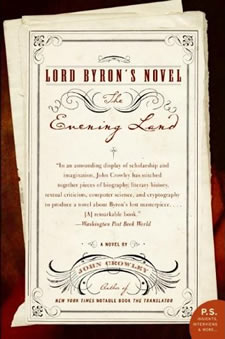 John Crowley
John Crowley
Lord Byron’s Novel: The Evening Land
(Harper Perennial, 2005)
One of the virtues of John Crowley’s book is that they can often be found in awful bookstores when it doesn’t seem like anything readable can be dredged up. I started reading the Ægypt books in Idaho; here in rural Virginia, I found myself a paperback edition of Lord Byron’s Novel: The Evening Land, which I wisely hadn’t gotten around to reading yet. It’s pleasant to read his books when cut off from civilization, although they’re the sort that do cry out for the Internet for fact-checking. Did Dr. Merryweather’s Tempest Prognosticator really predict the weather by means of leaches? Wikipedia claims this is true; their entry on Ada Lovelace, though, reads like the Book of Genesis, multiple authors telling the same stories over and over again in the hopes of eventually getting it right. One wishes for a better version of Byron’s poetry than the easily accessible Project Gutenberg editions; you can’t have everything. The dictionary app on my iPhone has a definition for “operose”: that’s something.
Lord Byron’s Novel consists of three parallel narratives. The first is Lord Byron’s novel, given the title The Evening Land, ostensibly saved from destruction at the hands of his wife by his daughter, Ada Lovelace, whose notes to the novel, at the end of each chapter, create a second chronology, following her reading of the book. Byron’s text takes up the majority of the book. Interlarded between chapters is a discovery narrative, composed of a trail of correspondence, mostly emails, sent to and from Alexandra Novak, an American woman in London doing research on Ada Lovelace for a website devoted to the forgotten history of women in the sciences; Ada has encoded the novel, and Novak and her partner seek to decode it. There’s not a great deal of suspense in this, as the reader has been reading Byron’s novel and knows that it’s accomplished. Rather, this third narrative seems to be working at different ends, examining what coincidence means in fiction and in life. Another plot emerges: Alexandra’s father, conveniently enough a former Byron scholar, has been estranged from his daughter: having left academia for a career in the movies, he commits a Polanski-like crime for which he must flee the country; largely on account of this, he is estranged from his daughter. Relations between fathers and children form a dominant theme: between Byron and his daughter Ada, who he never talked to; between Alexandra and her father; and between Byron’s hero Ali and his fictional daughter Una.
It’s neat, but not too neat. It’s difficult when reading a novel which consists of interplay between a text and its annotations, to avoid thinking of Pale Fire, which has almost always done the job more perfectly. Not that perfectly is necessarily the same thing as better: Nabokov’s book is constructed so tightly that it could only be fictional, and in its unrealistic world there’s no friction where the reader might be caught and held. Crowley doesn’t seem to be attempting to compete with this: his project here is different because there’s an interplay between the real biographical history of Byron and those around him and the fictionalizations that Crowley has created. When the reader is presented with a text ostensibly by Lord Byron with annotations by his daughter, Ada Lovelace, it’s clear that the exegesis in the notes actually operates in reverse. The similarities that Ada finds in Byron’s text to his own life aren’t the signs of a novelist disguising his own life by hiding it in fiction, but rather the raw materials that the reader knows that Crowley has used to construct a novel that might be Byron’s. The reader suspects that the notes might have preceded the novel: they’re the historical pieces from which fiction might be constructed.
This works in other ways as well: when a character appears named “Lord Corydon,” we know that we understand the name “Corydon” differently from the way that Ada would have, as Gide’s work wouldn’t appear until well after her death. Ada’s notes point out that Byron’s account in his novel of how the Duke of Wellington won the Battle of Salamanca is counterfactual; but we also know that the very existence of Byron’s novel (and Ada’s notes on it) is counterfactual. The author is winking at us: in less deft hands, this might be annoying, but it doesn’t happen often enough here to wear out its welcome. The text that is to be decoded appears mysteriously, in the hands of a figure who might be the author himself; late in the process, he appears again, to cast doubt on the truth of the rediscovered novel.
This isn’t experimental fiction, in the sense that Pale Fire was experimental when it appeared; rather, it takes a form (albeit one that hasn’t been used especially often) and puts it to good use. It’s a pleasant book, exactly right for vacation reading: hence my pleasure at being able to find John Crowley’s books in remote bookstores. The Evening Land might have stood alone: it’s an enjoyable pastiche of Romantic writing, a bit reminiscent of James Hogg’s Private Confessions of a Justified Sinner though without the supernatural aspects of that book. Someone must be compiling a dissertation on the appearance of the Internet in American fiction: Crowley’s grasp of the way people talk over email is surprisingly convincing and readable, and would belong in such a volume. In the earlier sections of the book, one finds oneself racing through the pseudo-Byron to reach the contemporary narrative; as the book progresses, interest reverses itself; it’s skilled writing that can maintain such interest.
alvin levin, “love is like park avenue”
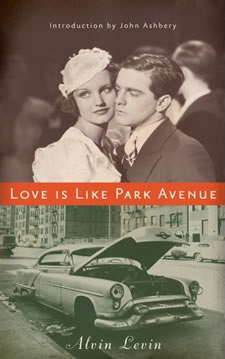 Alvin Levin
Alvin Levin
Love Is like Park Avenue
(ed. James Reidel)
(New Directions, 2009)
Love Is like Park Avenue collects the fiction of Alvin Levin, who was born in 1916, but seems to have given up writing fiction in 1943: seven years worth of writing, mainly short pieces, make up his entire literary output, not quite breaking 200 pages. The title, which appeared on two distinct pieces collected here, was to have been that of Levin’s novel, which never materialized; it’s hard to tell, from the content here, what form that novel would have taken, as Levin doesn’t seem to have been given to conventional unities of plot or character. The editor suggests that much of this material might have been part of a novel; but Levin has been dead since 1981, and his rumored novel was nowhere to be found in his possessions.
Levin, born in Paterson, New Jersey, grew up in the Bronx and attended City College; most, though not all, of his work seems to center around lower-middle class Jews in roughly similar situations. In his introduction, James Reidel notes that Levin had polio and walked with a crutch for most of his life; Reidel suggests that Levin lived vicariously through his younger sister, both in his life and in his fiction. (“A Cool Drink Is Refreshing,” written in 1939, might be the most straightforwardly autobiographical work here: the story is told from the perspective of a young woman who visits a boys’ school to tell her brother that their father has found him a job, delivering milk; the implication is that he’ll need to quit school.) It’s hard to tell how much to read into this: but Levin does have a pronounced sense of empathy, and he captures his women characters, narrators as often as not, remarkably well. Following the examples of Faulkner and Dos Passos, Levin generally uses a stream of consciousness narration; the point of view frequently shifts, and the narrator at the end of a piece (“story” seems the wrong word) often isn’t the one who started it. Names and locations sometimes shift capriciously; this seems to be intentional. His prose is always energetic: Levin is always an interested observer even if his exact position can be difficult to pin-point. The excerpt from a novel published in 1942 as “Love Is Like Park Avenue” is composed of a series of short vignettes, none longer than a few pages, each with different characters; there’s a unity to the world and vision that Levin presents, but the characters, their voices, and their situations are constantly shifting
Having grown up in the Depression, Levin’s subject is frequently the lower classes; but he never writes as a tourist, seeking to explain how the other half lives to an educated audience; nor is his writing polemical. There’s no disdain in his words; what he sees in life, and he puts it down on paper with the hope, perhaps, that someone will read it. It’s possible that this comes through most clearly because Alvin Levin was never actually a successful writer, though William Maxwell asked him to submit material to the New Yorker and the British poet Nicholas Moore asked him for a story for an anthology of avant-garde fiction. This doesn’t seem like writing for a mass audience or for an avant-garde audience; Levin appears to have been interested primarily in pleasing himself, a supposition that might be entertained because he seems to have voluntarily given up writing entirely. In Reidel’s telling, this seems to have been because he had many other interests keeping him busy: he was a lawyer, and seems to have run a successful pamphlet-publishing business for years.
Reading Levin now, one notices the kinds of fiction that we don’t have today. The contemporary American novel, or that subset of it known as literary fiction, is generally written by the upper class because it is written for the upper class. The social structures that generate fiction and its writers – MFA programs – are, with a few notable exceptions, self-selecting, limited to those who don’t need to make a living. It’s not an accident that the New Yorker, the most prominent venue where new fiction might be seen, is aimed squarely at those who aspire to be upper class. This isn’t something unknown – Walter Benn Michaels was making this argument a few years ago, albeit hamfistedly – but it’s generally not discussed, as class doesn’t tend to be discussed in America. This isn’t solely a contemporary problem – writing itself has always tended to limit itself to those who have the time and leisure to engage in it – but Levin’s book suggests that things have not always been quite so stagnant as they are now. Writing, for Levin, seems to have been a possible agent of social mobility, an aspirational vehicle: the upper classes wrote, but he could write too; by doing so, he could earn the prestige of a millionaire like James Laughlin, who corresponds with him like a peer. But avant-garde writing isn’t a viable way out of the lower middle class, especially if you need to support yourself because you’ve been crippled by polio; Levin might have realized this, and this might be why he turned away from writing. It’s hard to blame him, but it’s our loss.
It’s worth noting that this is an unusually attractive book for New Directions, whose recent work has been deeply disappointing given the publisher’s long history of good book design. Levin sought to be published by James Laughlin; his most prominent publications were in New Directions annuals, but James Laughlin never seems to have coaxed the promised novel out of him. James Reidel arranges his work chronologically, interspersing correspondence to and from potential publishers; useful notes complete the volume, and John Ashbery’s brief preface recalls how exiting his voice was in 1942 and explains his part in Levin’s republication. We’re lucky that Levin found the young Ashbery as a reader.
july 21–august 1
Books
- Frederick Rolfe, The Desire and Pursuit of the Whole
- Tom Rachman, The Imperfectionists
- Tan Lin, Seven Controlled Vocabularies
Films
- Sun Ra: A Joyful Noise, directed by Robert Mugge
- The Pajama Game, dir. George Abbott & Stanley Donen
- Thomas Bernhard. Drei Tage (Thomas Bernhard – Three Days), dir. Ferry Radax
Exhibits
- “Memories of the Future,” Sean Kelly Gallery
- “Poems & Pictures: A Renaissance in the Art of the Book (1946–1981),” Center for Book Arts
- “I will cut thrU: Pochoirs, Carvings, and Other Cuttings,” Center for Book Arts
tan lin, “seven controlled vocabularies”
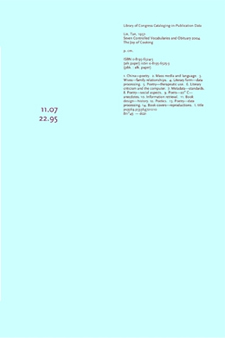 Tan Lin
Tan Lin
Seven Controlled Vocabularies and Obituary 2004. The Joy of Cooking
(Wesleyan University Press, 2010)
Like Tan Lin’s previous plagiarism/outsource, this is a book with a title in flux; I’m using the title on the spine, though the title page (appearing as a verso, not a recto) gives the title Seven Controlled Vocabularies 2004 [Airport Novel Musical Poem Painting Theory Film Photo Landscape], and the Library of Congress cataloging-in-publication data on the copyright page, recto, gives a further variation on those elements with different punctuation. (A first LoCC-I-PD appears on the front cover.) A spread after that gives the title as The Joy of Cooking; the next spread presents another variant. As far as I can tell, there are six different titles to this book. A foreword by Laura Riding Jackson appears, as the back cover promises, on page 162; this is not, of course, a foreword written for this book, but a photocopies of her foreword to her own Rational Meaning: A New Foundation for the Definition of Words and Supplementary Essays from 1986.
This is a book built from appropriations, from pieces of other books, as the title suggests; but more to the point, this is a book straining the forms of a book. Or possibly this is a book that explodes the bounds of books: at his recent book party at Printed Matter, Lin was a huge number of ancillary volumes created through Lulu; yet more material is floating around the web in various formats. I was given copies of Blurb and Selected Essays about a Bibliography, to which I contributed content; I’ve looked through these books and a number of the related works online, some of which, like the appendix seem integral to understanding Lin’s project. I certainly won’t pretend to have read everything: it seems impossible to tell where this book ends, or if it has ended.
How can we read Seven Controlled Vocabularies? The method suggested by the form is to dive in at random and float around for a while; to read it from front to back is perhaps to read this book against its grain, which is what I did. And one notices that despite the book’s chaotic appearance, the page numbers do march from the beginning of the book to the end in an entirely linear fashion, perhaps the most constant design feature of the book. The first text inside the book that one finds reading from the Western front cover is on what would be page 1 of the book: it says “[INSIDE BACK COVER]”. A Chinese edition of the book, available on Lulu, suggests that a front cover is sometimes a back cover; and so the front cover of this book might also be its back cover, and the back cover contains much of the same information available on the front. As one pages through the book, front matter appears, not necessarily where one might expect it; unexplained numbers (“11/07 2.21”) appear on one of the title spreads.
The first page number appears on page 9, where there appear acknowledgements. These are set in the same type (Scala Sans) as the rest of the book; on first glance, this seems like it might be straightforward. Details pop out though: the last line, a paragraph by itself, says that the photo on page 182 is by the author. Flipping to page 182 reveals a small photo, which might be by the author. The paragraph above it suggests that the illustration on page 45 is Stanley Spencer’s The Resurrection, Cookham; turning to that page reveals what looks like a photograph that isn’t of any sort of resurrection, though it might be a detail. But the illustrations that ostensibly appear on pages 237 and 256 can’t actually be found, as the book doesn’t have that many pages. Re-reading the acknowledgements, one realizes that it’s been lifted from another book; probably the book was not written when Lin was a “Post-doctoral Research Fellow at Liverpool John Moores University between 1999 and 2002” as one might believe. Google, ever useful, suggests that these acknowledgments are from Timothy Bewes’ Reification, or the Anxiety of Late Capitalism. The following page contains an editorial note, an authorial note on methods used to produce the book; it appears to be “real” in that Lin could have conceivably written it, but the seeds of doubt have been sown. Opposite is text in Chinese; it seems to be a translation of the editorial note.
The book proceeds: there’s a blank verso, then a recto with a heading. Flipping through the book reveals seven of these, presumably the Controlled Vocabularies of the title:
- A Field Guide to American Painting
- A Field Guide to the American Landscape
- American Architecture Meta Data Containers
- 2 Identical Novels
- A Dictionary of Systems Theory
- Various Library Standards
- A Field Guide to American Cinema
After the last, there’s an About the Author, which seems to be accurate. But out of the apparent chaos of this book, a structure can be discerned: inside each section, there does seem to be an internal grammar. The first section, for example, pairs text on the verso pages with labels for non-existent plates on the versos; the second section pairs text with photos, though the photos seem to be out of synch (in the style of Hollis Frampton’s film (nostalgia), obliquely referenced here) with the text.
Themes emerge through the book, though they seem to disappear almost as often as they pop up: the changing form of the book, of course; the meaning of plagiarism in contemporary composition; the parallel changing world of food; metadata as it relates to reading; reality television; the obscurantism of computer jargon; and perhaps how the canon has become something personal rather than universal. The Joy of Cooking, for example, has a very personal meaning to Tan Lin (which can be understood by reading the unincluded Appendix to this book); reading this book without that leaves the reader in the dark. Parts of this book remain obscure to me: how the photos in it work, for example. Some are probably of personal significance, as seemed to be the case with the photos in Lin’s earlier books; but right now I can’t make sense of them. I suspect that there’s a definite meaning there: but it may only be as part of an ecosystem of other, related books that those meanings might emerge.
noted, more
- Nicolas Carone has died.
- I wrote a piece about sitting with Marina Abramović for a Tumblr project someone’s putting together.
- The Book Depository’s live map is entrancing, though everyone else has noted that by now.
tom rachman, “the imperfectionists”
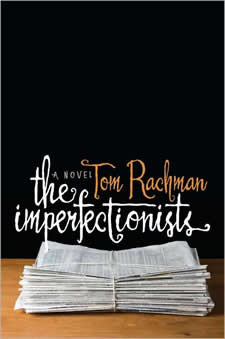 Tom Rachman
Tom Rachman
The Imperfectionists
(The Dial Press, 2010)
My friend C. sent me this book as a gift; several years ago, we wrote a travel guide to Rome together, and she had thought this book, written about a former AP staffer in Rome about a newspaper in Rome, might be interesting. She didn’t love it; I’d noticed the reviews and thought the book might have potential, even though the wrong sort of people were liking it, but after flipping through it in a bookstore I was confident that it wasn’t a book I needed to buy in hardcover. It’s nice to be sent a book as a gift, especially a book that someone has already read and marked up with their displeasure; there’s something nice about reading a book that you know you’re bound to dislike, figuring out exactly why you don’t like it.
What might be most interesting about this book is its structure: it’s constructed from 11 short stories, each given the title of a news story (a strategy that ends up coming off as a gimmick) and a subtitle with the name and position of a person who works at an English-language newspaper based in Rome which will close by the end of the book. Each story is relatively self-contained; there’s chronological progression through the stories, though they seem to happen from around November 2006 to around April 2007, dates which can be pegged by the news stories. Each story is told from the third-person perspective of a different character; characters recur, and complete stories can only be constructed by reading more that one story. This straitjacket approach to structure doesn’t always work; some characters are more extraneous than others (a judicious editor would have cut at least two and possibly three chapters) and a couple of major characters don’t get their own chapters. The success of such polyphony is decidedly mixed: the voices of the women, in particular, seem cartoonish – women in positions of power, for example, turn out to be vicious harpies with unsatisfactory sex lives – and the character that Rachman seems to be having the most fun writing, a veteran scoundrel reporter named Rich Snyder, is the most tangential to the greater narrative.
Each chapter concludes with a separate section, set off in italics; these report the history of the newspaper, starting with the newspaper’s founding in 1953 and moving into the present to converge with the main narrative at the end of the book. The newspaper itself would be the main spine of the book; this isn’t, however, as compelling as the people around it. At the end of the book, one of the characters has the intention of writing a history of the newspaper; but this history, we are told, is never started, and the italicized history is from an omniscient third-person perspective that is not his.
The book’s structure suffers from being similar to Georges Perec’s Life A User’s Manual, which also tells interlocking stories from multiple perspectives; Perec’s book constrains itself to a specific moment in time rather than a series of instants, as this book uses. Finishing Perec’s book, one feels compelled to go back to the beginning, to re-read the narratives, knowing how they will turn out; here, one notices clues, but the overall narratives aren’t enough to compel re-reading: one doesn’t feel that any more secrets are likely to reveal themselves.
My disappointment with the book os partially personal: having lived in Rome, though not during those particular years, I expect a certain amount of local color, something that should be possible. Unfortunately, this book seems to be set in Rome almost at random: there are details here and there, but the story could be uprooted and moved to Paris or Brussels without much trouble: cartographic details would need to be changed, but the overall structure (and almost all of the characters) of the book could remain exactly the same. Most are Americans in Rome; they don’t behave so much like ex-pats in Italy (a type that could be carefully delineated) so much as they behave like American characters, uprooted from America by authorial whim. A sulking character, for example, shuts herself up in her room and starts shoveling down Häagen-Dasz. It’s possible that American brand is now available in Italy; but almost certainly Americans in Rome are still likely to go on and on about how superior Italian gelato is than any American version. A surprising number of Romans love ice cream cones from McDonald’s; ex-pats go on and on about cultural imperialism. Italy seems to have little effect on these characters; some have the requisite Italian boyfriends and girlfriends, but nothing is learned from them. This is, of course, a purely personal complaint: the author has no duty to gratify me by making this book about what I want it to be about, even if that is more interesting and would make it a better book all around. There are a number of solecisms in the book, some of which might be attributed to a lack of a copyeditor familiar with what Rachman is talking about: “Fiumicino Airport” is not, for example, a proper noun but rather the town where Leonardo da Vinci International is located. But again, these mistakes aren’t likely to annoy most readers.
The biggest problem with the book, and one that might be related to its carelessness with setting, is how it strains credibility. I don’t have a problem with the rejection of conventional realism, of course; but this is a book which is using realism as its mode. (One exception, which triggered my earlier comparison to Life a User’s Manual: one character is a reader of the paper who has been making it her business to read everything in the paper, every day, with the consequent result that her chronology slips further and further from that of the outside world; finally, when she is missing a single issue, it breaks down entirely. But this is the only prominent instance of fabulism in the book.) When a book proceeds by realism, the reader losing faith in the book suggests a problem with the book. The premise of the book is that a billionaire sets out to run a world-class English newspaper out of Rome: this is problematic. Rome isn’t a place that anyone with a modicum of sense would think to do this; even limiting choices to Italy, it would make much more sense to work out of Milan, and if one were trying to get things done it would make much more sense to leave Italy entirely. Starting a major newspaper in Rome, romantic as it may sound, is somewhat akin to the idea of starting a major American newspaper somewhere like Albany. The reader wonders as well when it turns out that the newspaper doesn’t have a website. This might be believable if the book were set in 2000 or if the newspaper had some sort of specialist slant resistant to the Internet; when the paper seems to be modeled on the International Herald-Tribune and the book is set in 2006, when American newspapers were already on the point of collapse, it defies all belief, especially when this turns out to be a large part of the reason the paper collapses. That’s just not how businesses are run. One might suspend belief if there seemed to be some good reason for it, the setting, perhaps; but it’s not there.
